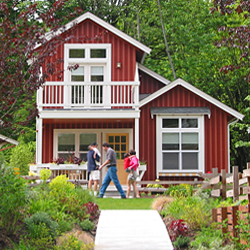|
|

 |
The Japanese phrase--muko sangen ryo donari--comes close to describing the scale of a pocket neighborhood. It translates as, “three houses across and one to either side and back”. These are one’s immediate neighbors.
|
|
|
|
Excerpts from the Book
A mom needs help looking after her kids while going for a short errand. The next-door family needs a cat fed while away on vacation. An elderly neighbor may need assistance trimming a hedge. In a pocket neighborhood, nearby neighbors are on a first-name basis with each other, the first to notice a need, and the to first call for assistance.
Impromptu encounters among nearby neighbors have them chatting about the garden, the latest news, or reminiscing about old times. These simple meetings may eventually grow into caring relationships, offering friendship as well as support at a challenging time.
For most of human history, the scale of community was confined to distances defined by walking. That changed with the automobile, national highway system, telephones, jet travel and now, online social networking. These technologies brought benefits, but the extended communities they created left many people isolated as well. Pocket neighborhoods can re-establish communities where nearby neighbors can respond to daily needs in a way that friends across town and family across the country cannot — mending webs of belonging, care and support needed in a frayed world.
Lets face it: humans are gregarious—we like to live around others. We also have a desire—and perhaps a need—for personal space. Sometime in the last generation, however, we became so charmed with the dream of a ‘house of one’s own’ that we overshot our desire for privacy, leaving us marooned on our own personal island in a sea of houses.
The front porch is an essential facet of a pocket neighborhood. Its magic comes from the way it is both private and public, belonging to the household while being open to passersby. Sometimes it’s just the right spot to read a book or take an afternoon nap. At other times the porch’s somewhat-public nature is perfect for a chat with passing neighbors — welcoming, without having to invite them inside.
Simultaneously, a picture began formulating in my mind that was like the Russian nesting dolls: individual houses have their own private yards, nested within pocket neighborhoods of homes on a block or alley, all within a larger sub-neighborhood bordered by busy city streets and a park. This community is then nested within a district within the city. It was a picture of a whole and healthy small-scale community within a large scale world—not just an idea, but the real thing. |
|